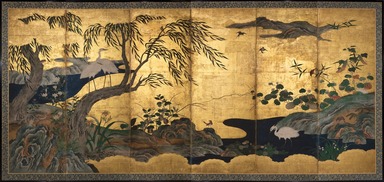
Artist:Kano Shôei
Medium: Ink, color, gold leaf and gold fleck on paper
Geograhical Locations:
Dates:late 16th century
Dimensions: Unfolded, overall: 68 3/4 × 147 11/16 in. (174.6 × 375.2 cm) folded: 69 x 25 1/2 in. (175.3 x 64.8 cm) image (outer panel): 62 3/8 x 26 7/8 in. (158.4 x 68.3 cm) image (inner panel): 62 3/8 x 24 3/8 in. (158.4 x 61.9 cm)
Collections:
Accession Number: 83.183.1
Image: 83.183.1_PS11.jpg,
Catalogue Description: Birds and Flowers. One of a pair of 6-panel screens; ink, color, gold leaf, and gold fleck on paper. This is the left-hand screen of the pair. The screens represent a variety of plants and animals associated with the late spring, summer, and early autumn in Japan. Prof. Matthew McKelway notes that most of the species and varieties are native to Japan, with some of the birds passing through Japan in the summer months. Reading from right to left, the subjects are as follows: Panel 1:Gourd, cucumber, and pumpkin vines twist around bamboo stalks, with an bird preening below (perhaps the female of the red-and-black bird in the next screen) next to bamboo grass, with three-leaf arrowhead (omodaka) at the bottom. Panel 2: Melons and more pumpkins on vines, with an unidentified red-and-black bird on a bamboo stalk. One of two sparrows flies above, and a white egret wades below, with drawf waterlilies (hitsujigusa) and fringed waterlilies (asaza). Panel 3: A Japanese robin (komadori) perches on a rock with a second swallow flying above. Panel 4: Under the branches of a willow, eggplants grow with a trio of Siberian meadow buntings (hojiro) below and an unidentified bird perched above. Panel 5: Two white egrets perch on the trunk of the willow, with orange daylilies (wasuregusa) below. Panel 6: Siberian rubythroat (nogama) perched on another willow, above two Eurasian skylarks (hibari) on a rock, with crabgrass and gardenias in the foreground and marigold in the midground. Blue and gold brocade borders, black lacquer wood frame with bronze fittings, stencil printing paper back. Condition: Very minor old repairs, new 11 1/2" diagonal split near upper right of panel 4. July 11, 1984: closed open split and touched up gold leaf as follows: Upper center of left panel, upper left of second panel from left, upper center and middle right edge of third panel, upper left, lower center and middle right of fourth panel, upper left of fifth panel, upper left and center left of 6th panel. Hinges were sound. Technique: open splits, insert paper and wheat paste, close split and match gold leaf on surface. Work completed by Kazufumi Homma, restorer, in TBM Conservation lab. Examined 6/4/90 by Sondra Castile, Conservator from the Met. 83.183.b (left-hand screen): 8/6/93: Conservator's report (record of restoration) condition: Fair. Repaired and retouched numerous times. Number of fresh tears resulting from shrinkage of the paper support. Counting the panels from left to right, the tears are located as follows: #1, top right corner; #2, top left corner; #3, top and bottom right corner; #4, top left and bottom left and right corner; #5, top right corner; #6, top left. The screen itself is in fairly good condition. The silk borders are discolored and worn, and lifting at the far left top corner. Treatment; the torn areas were re-adhered, as was the silk border at top left. The gaps between the edges of the torn paper were inpainted. Lifting areas were re-adhered. (JD)